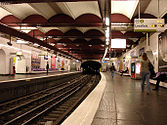Opéra station (Paris Métro)
Opéra is a station of the Paris Métro, named after the nearby Opera Garnier, built by the architect Charles Garnier. It is located at the end of the Avenue de l'Opera, one of the accesses being opposite the Opera, and serves the district of the Boulevard Haussmann. Three Métro lines (3, 7 and 8) cross each other at one point, known as a "well".
The station offers a connection to the following stations:
- Auber on RER line A
- Haussmann – Saint-Lazare on RER line E
- Havre – Caumartin on lines 3 and 9
- Saint-Augustin on line 9
- Saint-Lazare on lines 3, 12, 13 and 14
The station is famous for its strong odors of sewers. When it was being built, there were concerns that one of Hector Guimard's characteristic iron metro entrances would spoil the view of the opera house, so a marble entrance was built instead.
History

The line 3 platforms opened on 19 October 1904 as part of the first section of the line opened between Père Lachaise and Villiers. A twenty metre high masonry well was built to avoid the need for heavy underpinning work when lines 7 and 8 were planned to be built. This work was affected by groundwater, which required the support of three concrete pillars, made by sinking caissons with workers digging out the mud with compressed air. The work lasted eleven months, from March 1903 to February 1904.[1] The line 7 platforms opened on 5 November 1910 as part of the first section of the line opened between Opéra and Porte de la Villette. The line 8 platforms opened on 13 July 1913 as part of the first section of the line opened between Opéra and Beaugrenelle (now Charles Michels station on line 10).
Station layout
| Street level | Accesses | |
| B1 | Mezzanine for platform connection | |
| Line 3 platforms | ||
| Westbound | ← | |
| Eastbound | | |
| Line 7 platforms | ||
| Southbound | ← | |
| Northbound | | |
| Line 8 platforms | ||
| Westbound | ← | |
| Eastbound | | |
Gallery
-
Line 3 platforms at Opéra
-
Line 7 platforms at Opéra
-
Line 8 platforms at Opéra
-
Opéra platform signage
References
- ^ Robert, Jean (1983). Notre métro ("Our metro") (in French). p. 54.






